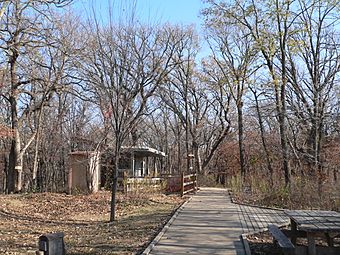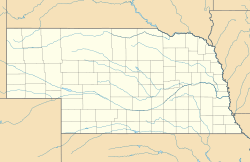Fontenelle Forest facts for kids
Quick facts for kids |
|
|
Fontenelle Forest Historic District
|
|

Boardwalk trail on upper level of Fontenelle Forest, near visitor center
|
|
| Location | Bellevue, Nebraska |
|---|---|
| NRHP reference No. | 74001139 |
| Added to NRHP | January 21, 1974 |
Fontenelle Forest is a huge forest in Bellevue, Nebraska. It covers about 1,500 acres (6.1 km²). This amazing place has lots of fun things to do. You can explore hiking trails, visit a nature center, or enjoy a picnic. It's also a special place. It's known as a National Natural Landmark and a National Historic District. The forest has many different areas. These include hardwood forests, wide floodplains, loess hills, and marshlands.
Contents
History of Fontenelle Forest
People have lived near Fontenelle Forest for a very long time. Woodland culture Indians lived here over a thousand years ago. Later, the famous Lewis and Clark Expedition camped nearby. This happened on July 27, 1804.
Early Trading Post
In 1823, Joshua Pilcher started a trading post. It was near the forest's big marsh. This post was for the Missouri Fur Company. It was on the edge of lands used by the Omaha and Otoe tribes. Later, a French-American trader named Lucien Fontenelle bought the post. It then became known as Fontenelle's Post.
The fur trade began to slow down. So, Lucien Fontenelle sold the post in 1832. The government used it as the Bellevue Indian Agency. This agency worked with local Native American tribes.
Logan Fontenelle's Role
Lucien Fontenelle passed away in 1840. His oldest son, Logan Fontenelle, then came back to Nebraska. Logan was very smart. He could speak Omaha, English, and French. When he was 15, he started working. He became an interpreter for the US Indian agent. His mother was the daughter of Big Elk, a main chief of the Omaha people.
Logan Fontenelle helped with important talks. He was an interpreter when the Omaha people signed a land treaty in 1854. This treaty gave some Omaha land to the United States. Many people in the past thought Logan was a chief. However, the Omaha people considered him white because his father was white. Both Logan and his father are buried somewhere in the forest. Their exact burial spot is not known.
Protecting the Forest
In 1913, two doctors, A.A. Tyler and Dr. Harold Gifford, Sr., started something new. They created the Fontenelle Forest Association. Their goal was to protect the woodlands. These woods were south of Omaha, Nebraska along the Missouri River. They bought their first land for preservation in 1920. The association named the forest after Logan Fontenelle.
A small nature center opened in 1966. Volunteers led popular educational hikes there. In 2000, the group changed its name to Fontenelle Nature Association. Then, in 2012, they changed it back to Fontenelle Forest. Today, Fontenelle Forest protects over 2,000 acres. This includes forests, prairies, and swamps. It is one of the largest natural deciduous forests in Nebraska.
Facilities at Fontenelle Forest
Fontenelle Forest has several great buildings for visitors.
Forest Learning Center
The Katherine and Fred Buffett Forest Learning Center is the main building. It was built in 2000. This center is used for many things. It hosts school programs and public education events. It can also be rented for private events.
Wetlands Learning Center
About two miles from the main center is the Gilbert and Martha Hitchcock Wetlands Learning Center. This center opened in 1999. It has special spaces for learning about wetlands. It's next to the Gifford Memorial Boardwalk. This boardwalk is about 3/8 of a mile long. It leads to a two-story tower. From the tower, you can see the amazing Great Marsh.
Fontenelle Forest also manages another area. It's called Neale Woods and is north of Omaha.
Wildlife in Fontenelle Forest
Fontenelle Forest is a fantastic place for animals. It's located along the Missouri River Valley flyway. This is a major path for birds.
Bird Watching Paradise
The Audubon Society says that 246 different kinds of birds have been seen here. This includes 35 types of warblers. Birder’s World magazine even called it one of the top ten places in the United States to see warblers. Bird Watching magazine said it's the best place to see eastern birds near the western edge of their homes. You can also see western birds near their eastern homes.
It's the only place in Nebraska where red-shouldered hawks have built nests. It's also one of the few places in the state with pileated woodpeckers. Other cool birds you might see include the Kentucky, prothonotary, and cerulean warbler. You might also spot a wood thrush, grasshopper sparrow, or whip-poor-will.
See also


